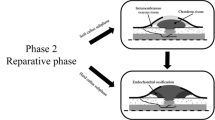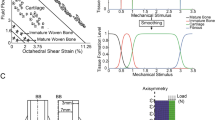Abstract
The process of healing of fractured bone is known to be influenced by the mechanical environment and the loads exerted by physical activity of the patient or otherwise. We compute mechanical fields in the soft connective tissue of the healing fracture using Biot's poroelasticity model and a finite element (FE) method for low-frequency loading. A two-scale FE framework is used to model effects of the rough bone-callus contact surface. We look at the difference the interface roughness makes with respect to different possible mechanostimulating agents.
Similar content being viewed by others
REFERENCES
V. Beilin and G. N. Pande, “Simulation of the confined compression test of soft tissue with Conheat3d,” Technical Report, Civil Eng. Dept., University of Wales Swansea (1998).
M. A. Biot, “General theory of three-dimensional consolidation,” J. Appl. Phys., 12, 155-164 (1941).
A. H.-D. Cheng and J. A. Ligget, “Boundary integral equation method for linear porous-elasticity with applications to solil consolidation,” Int. J. Num. Meth. Eng., 20, 255-278 (1984).
J. Kenwright and A. E. Goodship, “Controlled mechanical stimulation in the treatment of tibial fractures,” Clinical Orthopaed. Related Res., 241, 37-47 (1989).
J. Klein-Nulend, A. van der Plas, C. M. Semeins, N. E. Ajubi, J. A. Frangos, P. J. Nijweide, and E. H. Burger, “Sensitivity of osteocytes to biomechanical stress in vitro,” FASEB J., 9, 441-445 (1995).
R. W. Lewis and B. A. Schrefler, The Finite Element Method in the Deformation and Consolidation of Porous Media, Wiley (1987).
P. J. Prendergast, W. D. van Driel, and J.-H. Kuiper, “A comparison of finite element codes for the solution of biphasic poroelastic problems,” Proc. Inst. Mech. Eng., Pt. H: J. Eng. Med., 210, 131-136 (1996).
R. L. Spilker and T. A. Mexian, “A mixed penalty finite element formulation of the linear biphasic theory for soft tissues,” Int. J. Num. Meth. Eng., 30, 1063-1082 (1990).
R. L. Spilker, J.-K. Suh, and V. C. Mow, “A finite element formulation of the nonlinear biphasic model for articular cartilage and hydrated soft tissues including strain-dependent permeability,” in: R. L. Spilker and B. R. Simon (eds.), Computational Methods in Bioengineering, ASME, New York (1988), pp. 81-92.
J.-K. Suh, R. L. Spilker, and M. H. Homes, “A penalty finite element analysis for non-linear mechanics of biphasic hydrated soft tissue under large deformation,” Int. J. Num. Meth. Eng., 32, 1411-1439 (1991).
Author information
Authors and Affiliations
Rights and permissions
About this article
Cite this article
Beilin, V., Pande, G.N. & Ito, K. Numerical Simulation of the Influence of Rough Bone-Callus Interface on the Healing of Fractured Bone. Mechanics of Composite Materials 36, 373–378 (2000). https://doi.org/10.1023/A:1026643016461
Issue Date:
DOI: https://doi.org/10.1023/A:1026643016461




